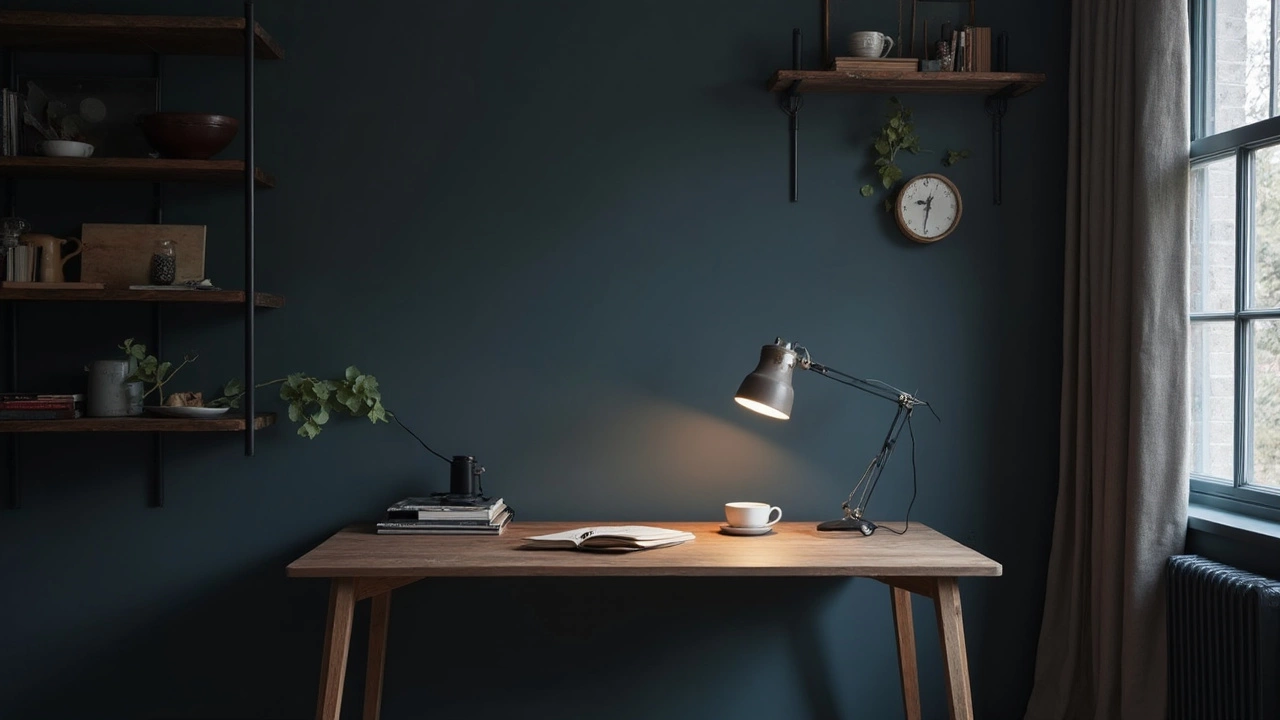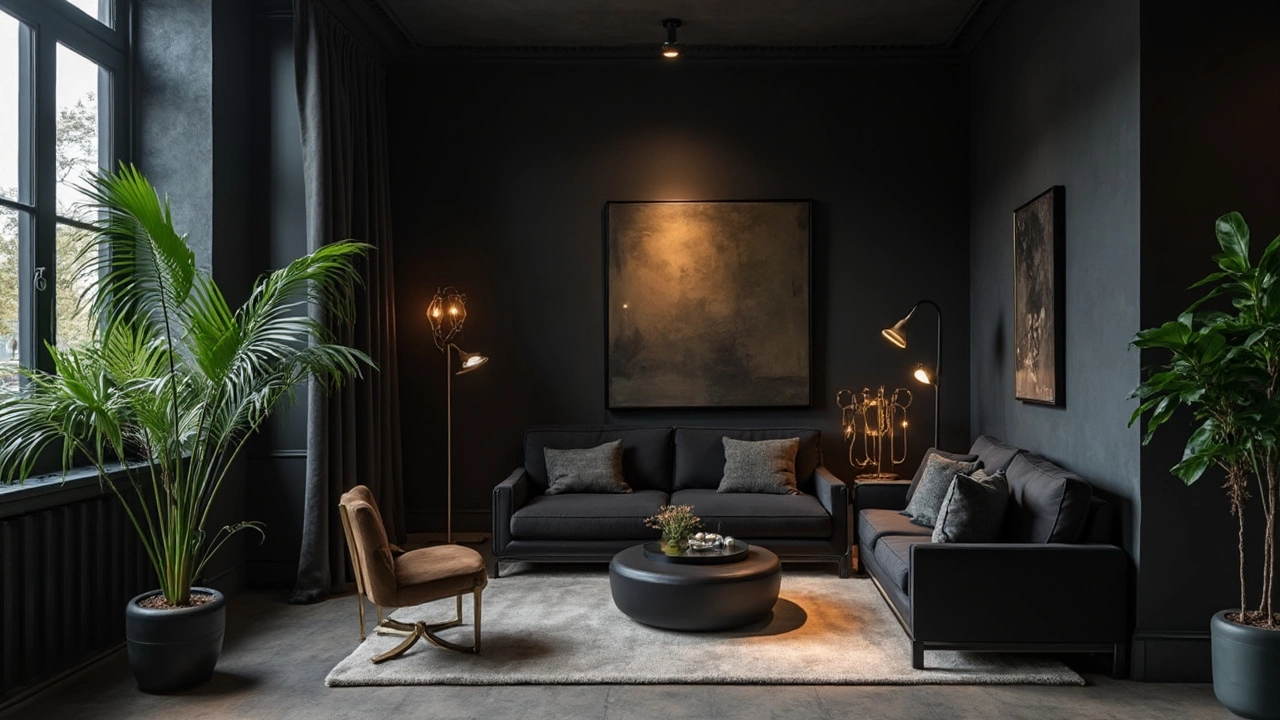Tired of spaces that look like sterile hospital rooms? If the usual bright-white minimalism feels a bit bland, dark minimalism can completely flip your idea of what “simple” should look like. Here’s where you trade blinding white for graphite, charcoal, inky black, and moody forest green. Instead of feeling cold or depressing, these colors—paired with sharp lines and straightforward layouts—make everything feel a bit more personal and interesting. You still get the clean, clutter-free peace of minimalism, but with more depth and attitude.
So, what’s the point? In a world packed with distractions, it’s refreshing to have a home that’s both chill and edgy. Dark minimalism dials down visual noise, helping you focus on what matters. No more scattered knickknacks or dizzying patterns. You get fewer items, but each piece pops: matte black lamps, a single dark wood table, maybe a dramatic charcoal accent wall. Even everyday stuff—like your coffee mug—feels richer and more intentional. People find it soothing, especially at night, since softer, darker surroundings can help your brain wind down.
- What Makes Dark Minimalism Different?
- The Perks and Drawbacks of Going Dark
- Real-Life Tips for Dark Minimalist Spaces
- More Than Decor: How Dark Minimalism Shapes Mindset
What Makes Dark Minimalism Different?
So, what sets dark minimalism apart from regular minimalism? First off, it’s all about that mood. Traditional minimalism leans on bright whites and airy vibes, while dark minimalism goes for bold, deep colors—think charcoal, navy, graphite, and even smoky greens. You can spot it right away: it’s sleek, confident, and way less sterile.
Instead of ditching all your stuff and living in a white cube, dark minimalists keep only what’s functional and beautiful, but they let the objects and space have a bit of edge. Furniture and decor usually have straight lines and unfussy shapes. What jumps out is the dramatic contrast: a matte black table next to a cream couch, bare windows framed by deep gray curtains. Warm woods, cool metal, and dark stone get used a lot, making the whole space feel grounded and intentional.
Lighting is a whole different story too. In classic minimalism, you want light flooding every corner. In dark minimalism, soft pools of light matter more than blinding overhead fixtures. Table lamps with low bulbs, discreet LED strips, or even candles are huge. This setup feels calmer, almost like a chill lounge instead of a showroom.
- Colors are always dark but never gloomy—look for shades that add depth, not just black for black’s sake.
- Materials matter: matte or textured finishes beat glossy surfaces hands down. They don’t scream for attention.
- Every item counts. You won’t see clutter; each piece gets to shine.
- Contrast is key: a single light object in a dark room instantly becomes a focal point.
There’s also psychology behind it. According to a 2022 survey by a design agency, around 34% of people found dark minimalist spaces helped them feel more relaxed and focused compared to lighter spaces. That’s a big deal for mood at home or work.
The Perks and Drawbacks of Going Dark
Switching to dark minimalism is more than just swapping out light paint for charcoal tones. There are some pretty real upsides, but it isn’t for everyone or every space. Let’s break down what you really get—and what to look out for—when you go dark.
- Looks super modern and bold. Darker shades instantly make a room look high-end, even with basic, budget-friendly furniture. That sleek, stylish look just sticks, especially when you keep your stuff to a minimum.
- Helps you unwind. Studies have shown that darker surroundings in the evening can help signal your brain that it’s time to relax. This can boost sleep routines for people who feel wound up at night.
- Shows off your stuff. With fewer distractions and contrast from deep colors, your favorite pieces—a cool lamp, a piece of art—really pop, making your choices feel intentional instead of random.
- Hides mess—sometimes. Dark colors can mask certain types of dirt or wear in busy places (think scuffs or coffee spills on black tables), but this isn’t always true if you have pets with light fur or live somewhere dusty.
| Perk | Reality Check |
|---|---|
| Modern Style | Might look cold if overdone |
| Cozy Vibes at Night | Can feel gloomy on rainy days |
| Easy to Clean (Dark Decor) | Shows dust and pet hair more than light colors |
But that edgy look does have some drawbacks. Using too much black or navy, especially in small rooms with little sunlight, can make spaces feel smaller or cavelike. Unless you’re a cleaning pro, those deep surfaces might turn into dust magnets (seriously, every stray hair shows up on matte black furniture). Plus, painting walls dark isn’t always simple to undo—if you rent, your landlord probably won’t love it.
Before you dive in, ask yourself how much light your space gets and if you’re ready to stay on top of dust. Good lighting—layered with lamps and warm bulbs—matters more in a dark minimalist setup than with a bright one. If you live for sunlight or hate vacuuming up pet hair, this style might drive you nuts. But get it right, and you’ll have a spot that's restful, stylish, and totally you.

Real-Life Tips for Dark Minimalist Spaces
Getting into dark minimalism isn’t just about slapping on some black paint and calling it a day. There are real tricks to pulling it off so your space feels stylish, not gloomy or cramped.
- Start with one feature wall. Going all-in on deep colors can feel overwhelming if you’re new to this. Test the waters with a single dark accent wall—charcoal, navy, or deep forest green usually work for most rooms. It gives drama without sucking out all the light.
- Keep the furniture simple but bold. Stick with basics: a chunky black sofa, a solid wood dining table, or metal stools. Choose quality over quantity—one statement piece outshines a dozen tiny decorations. Open spaces around furniture let the shapes actually stand out.
- Mix textures, not patterns. Pair rough stone, velvet, or leather with smoother surfaces like glass or lacquer. This makes the room feel more alive, not flat. Avoid wild patterns—they clutter up the clean lines that make minimalism pop.
- Don’t ignore lighting. Natural light becomes your best friend in a darker room. Keep window treatments sheer or skip them. Add low, warm lights like table lamps, wall sconces, or under-cabinet LEDs. Just one harsh ceiling light kills the whole vibe.
About 64% of people interested in minimalist lifestyle say they feel calmer in rooms that use darker, more saturated colors, according to a 2023 interior design trends survey.
- Use handy storage. Closed cabinets in matte black or dark wood keep clutter out of sight—essential for that “less is more” look. Baskets and boxes (all in similar shades) help stash stuff without breaking the mood.
- Add a bit of green. A few plants in black planters break up all the dark and add a bit of organic freshness. Snake plants, rubber trees, or ZZ plants are perfect because they don’t need tons of light.
- Edit your décor often. Rotate out anything that’s not earning its spot. Remember, dark minimalism is about focus. Zero in on what’s useful and visually satisfying to you—don’t just copy what you see online.
The best part? A well-styled dark minimalist room actually stays cleaner because you’re forced to be pickier about what you bring in. Plus, dark floors and tabletops don’t show tiny stains as easily as white ones do.
More Than Decor: How Dark Minimalism Shapes Mindset
It’s easy to think dark minimalism is just an interior trend, but the real change hits your daily routine and headspace. When you swap clutter for clarity and bold, dark colors for endless white, you start seeing things—literally and mentally—differently. Empty space isn’t just for show. Research from Princeton in 2011 confirmed that getting rid of visual mess helps people process information faster and reduces stress. The less you see, the less your brain has to filter. It’s not just cleaner—it’s quieter, too.
You might notice you’re more focused in a dark minimalist space. The moody shades and lack of junk make distractions harder to find. Try working on a black-top desk compared to a noisy, patterned one—your mind chills out, and it’s easier to lock in on what you’re doing. At night, rooms with deep colors and simple shapes can help you wind down, since darker surroundings boost melatonin production (goodbye, insomnia).
This lifestyle also brings less FOMO. Instead of always chasing the next new gadget or decor piece, you learn to appreciate what you already have. It’s about choosing less, not just owning less. Every item gets to earn its spot, so you value it more—and that’s a solid way to train yourself out of restless, mindless shopping.
Want to see mindset hacks in action? Here are a few ways dark minimalism can actually make your days smoother:
- Intentional choices: You buy and keep only what truly fits your life (and style).
- Less decision fatigue: Fewer options means less pointless staring at shelves every morning.
- Boosted calm: Science says calming spaces lower your blood pressure and stress hormones.
- Better evenings: Soft lighting and moody colors still your mind for actual rest, not just scrolling TikTok.
Think of dark minimalism as a reset button for your brain. It’s not just a style—it’s a filter that helps you ditch what doesn’t matter and finally pay attention to what does.





